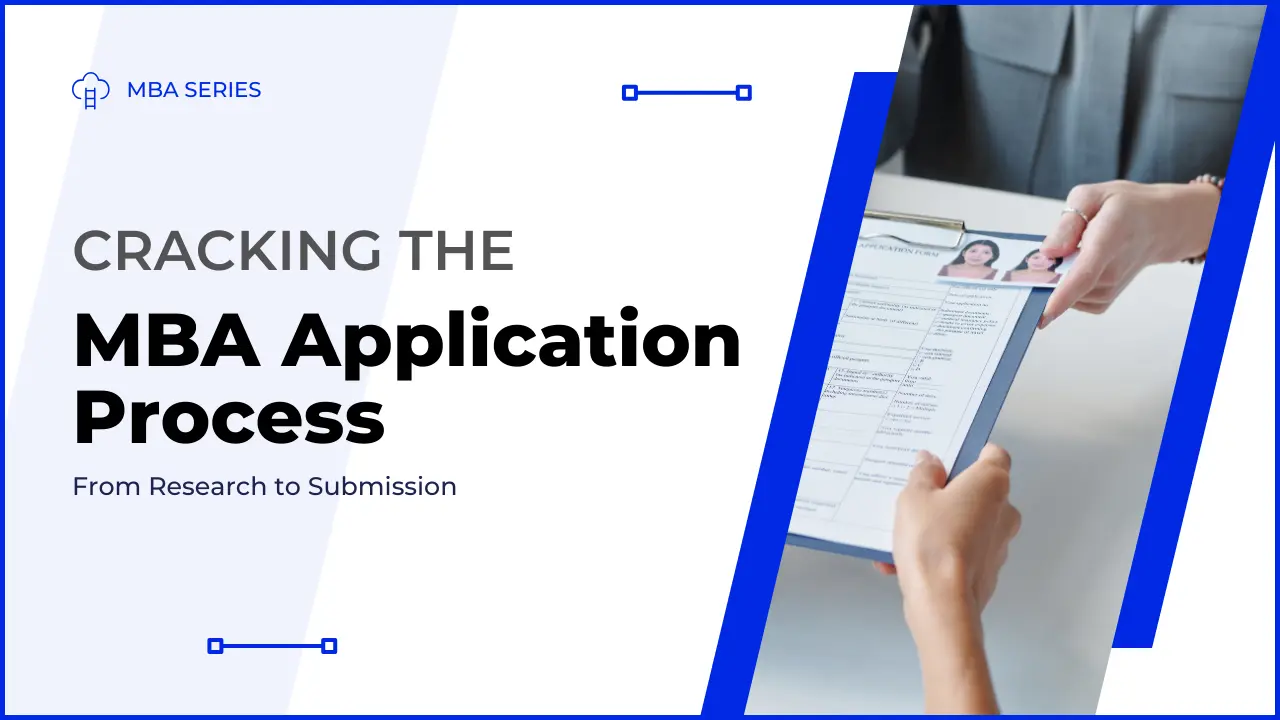Ever felt that applying to B-school is harder than cracking the IIT-JEE?
You’re not alone.
Here’s a mind-blowing stat:
Only 1 in 10 applicants gets into a top MBA program.
But here’s the kicker: It’s not always the smartest or most accomplished candidates who get in.
It’s the candidate who nails the MBA application process that get that golden ticket!
And that’s exactly what you’re about to learn – how to ace the MBA Application process and get into the school of your dream.
In this ultimate guide, you’ll discover:
- The foolproof MBA application timeline that’ll keep you ahead of the game
- A step-by-step checklist that leaves no stone unturned
- The “Secret Sauce” for researching schools that 90% of applicants miss
- How to turn your application from “meh” to “wow” in 3 simple steps
And a whole lot more.
But first, let’s address the main issue:
Why do Most MBA Applications Fail?
If you’re like most Indian applicants, you’ve got a killer GMAT score, a degree from a top college, and solid work experience.
But here’s the problem:
So does everyone else.
Your application is your chance to stand out. To show the Admission Committee (Adcom) why YOU deserve that seat more than the thousands of other applicants.
And that’s where mastering the MBA application process comes in.
At Crackverbal, we’ve guided thousands of Indian applicants through the MBA maze. And we’ve distilled all that knowledge into this guide.
Ready to turn your application into an admit-winning masterpiece?
Start Your MBA Journey with a Free Profile Evaluation Today
Start Your MBA Journey with a Free Profile Evaluation Today
The MBA Application Process: A Bird’s Eye View
Applying to B-school isn’t just about filling out forms and writing essays. It’s a journey of personal branding and self-discovery.
Here’s what that journey looks like:
- Self-Reflection: Understanding your story, your goals, and why you want an MBA.
- Research: Finding the right programs that align with your goals and values.
- Preparation: Taking the GMAT/GRE, updating your resume, and gathering your materials.
- Storytelling: Crafting your narrative through essays and short answers.
- Recommendations: Securing the right recommenders who can speak about your potential.
- Interviews: Bringing your application to life in face-to-face (or screen-to-screen) interactions.
- Waiting: Managing the post-submission period, including potential waitlist strategies.
- Decision: Celebrating admits, navigating waitlists, or redirecting in case of rejects.
Each of these stages is crucial, and they all work together to present a cohesive, compelling picture of who you are and why you’re an asset to any MBA program.
But here’s where most applicants go wrong:
They treat each stage as a separate task, missing the big picture.
Don’t be that applicant.
In the next section, we’ll unveil a powerful timeline that’ll help you nail every stage of the process.
Ready to become an MBA application process ninja?
Let’s keep going!
The MBA Application Timeline: Your Roadmap to Success
Alright, future MBA mogul! You know the stages of the application process. Now, let’s map them onto a timeline that’ll keep you ahead of the game.
Here’s the timeline that’s helped several Crackverbal students crack top B-schools:
12-18 Months Before Desired Start Date:
- Start GMAT/GRE prep (Yes, this early! Trust us.)
- Begin researching schools (More on this later)
- Reflect on your goals and reasons for pursuing an MBA
Pro Tip: Use this time to experiment with different GMAT/GRE prep methods. Find what works for you before the pressure really kicks in.
8-12 Months Before:
- Take GMAT/GRE (Leave time for a retake if needed)
- Narrow down your school list
- Start drafting your resume and essays
Pro Tip: Schools release their essay prompts around this time. Set up alerts so you’re first to know!
6-8 Months Before:
- Finalize your school list
- Approach potential recommenders
- Attend information sessions and connect with current students/alumni
Crackverbal Hack: Create a “recommendation packet” to give to your recommenders in which your key achievements, goals, and school-specific info will be mentioned. They’ll thank you for it!
3-6 Months Before:
- Complete and submit applications for Round 1 schools
- Prepare for interviews
- Plan school visits if possible
Warning: This is crunch time. Clear your schedule and prepare for some late nights!
1-3 Months Before:
- Complete and submit Round 2 applications
- Attend interviews
- Stay engaged with your target schools
Pro Tip: Keep a journal during this time. It’ll help you process the experience and provide material for potential update letters.
Now, here’s where most applicants drop the ball:
They see this timeline as a rigid schedule. But it’s not.
Think of it as a framework, not a straitjacket. Adjust the timeline based on your specific situation and schools’ deadlines.
Remember: The early bird gets the worm, but the second mouse gets the cheese. It’s important to balance “I’m prepared” with “I need to give myself enough time to put my best foot forward”.
Start Your MBA Journey with a Free Profile Evaluation Today
Start Your MBA Journey with a Free Profile Evaluation Today
Start Your MBA Journey with a Free Profile Evaluation Today
The Ultimate MBA Application Checklist: Leave No Stone Unturned
You’ve got your timeline for your MBA application process. Now it’s time for the nitty-gritty.
Here’s a comprehensive checklist that’ll make sure you’ve covered all your bases:
1. Define Your Goals
- Clarify short-term and long-term career objectives
- Articulate why you need an MBA to achieve these goals
- Identify skills and knowledge you need to gain
Pro Tip: Write a “future resume” for yourself 5 years post-MBA. It’ll help clarify your goals.
2. Research Programs
- Create a list of potential schools based on your goals and preferences
- Understand each school’s unique culture, strengths, and values
- Attend information sessions and connect with current students/alumni
- Narrow down your list to your top choices
Crackverbal Hack: Create a decision matrix. Rate schools on factors like location, specializations, and post-MBA placement. It’ll make your final decision much easier.
3. Prepare for Standardized Tests
- Decide between GMAT and GRE based on your strengths and target schools
- Create a study plan
- Take practice tests regularly
- Schedule and take the actual test
- Retake if necessary
Pro-tip: Don’t underestimate the importance of mock tests. They’re your best predictors of actual performance.
4. Craft Your Application
- Update your resume to highlight achievements relevant to your MBA goals
- Write your essays using storytelling techniques (Check out our guide on MBA Essay Writing!)
- Prepare any additional materials required (e.g., video essays, portfolios)
Pro-tip: Your resume and essays should tell a cohesive story. Make sure they complement, not contradict, each other.
5. Secure Strong Recommendations
- Identify potential recommenders
- Approach and brief your recommenders
- Provide necessary materials and follow up regularly
Pro Tip: Choose recommenders who can speak to different aspects of your candidacy. Variety is key!
6. Ace Your Interviews
- Research common MBA interview questions
- Practice with mock interviews
- Prepare thoughtful questions for your interviewer
Pro-tip: Record your mock interviews. Watching yourself can be cringeworthy, but it’s the fastest way to improve.
7. Manage Post-Submission Period
- Stay in touch with the school
- Prepare a waitlist strategy, just in case
- Continue to collect achievements and updates
Pro-tip: The waiting game is tough. Have a support system in place to keep you sane.
8. Make Your Decision
- Compare offers if you’re admitted to multiple programs
- Consider factors like fit, finances, and future goals
- Make an informed decision and start preparing for your MBA journey!
Pro Tip: Trust your gut. If a school feels right, it probably is.
Now, here’s the million-dollar question:
How do you turn this checklist from a to-do list into an “already-done” list?
That’s exactly what we’ll cover in the next section.
The “Secret Sauce” for Researching Schools: Go Beyond the Brochure
Alright! Now you’ve got your timeline and your checklist for your MBA application process. But how do you make sure you’re applying to the right schools?
Here’s where most applicants go wrong:
They skim the school websites, check the rankings, and call it a day.
Big mistake. HUGE mistake.
Here’s the secret sauce for researching schools that’ll make you stand out:
1. Become a Social Media Detective
- Follow the school’s official accounts, but don’t stop there.
- Join MBA forums and groups where current students and alumni hang out.
- Follow professors and thought leaders associated with the school.
Pro Tip: Set up Google Alerts for your target schools. You’ll be the first to know about new developments.
2. Dive into the Course Catalog
- Don’t just read the course titles. Dig into the syllabus if available.
- Look for unique courses or teaching methods that align with your goals.
- Pay attention to professors’ backgrounds and research interests.
Insider Secret: Many schools offer sample classes online. Take them! It’s the closest you’ll get to sitting in a real MBA classroom.
3. Stalk the Career Report
- Go beyond the average salary. Look at industry breakdowns and job functions.
- Check which companies recruit on campus.
- See if they have data on international placements (crucial for Indian applicants!).
Pro-tip: Don’t just focus on the numbers. Look for trends over the past few years.
4. Attend Events (Virtual or In-Person)
- Information sessions are great, but look for more niche events.
- Webinars on specific topics or industries can give you deeper insights.
- If possible, visit the campus. Nothing beats first-hand experience.
Pro-tip: Prepare thoughtful questions for these events. It’s your chance to make an impression before you even apply.
5. Connect with Current Students and Alumni
- LinkedIn is your best friend here. Don’t be shy about reaching out.
- Look for alumni from similar backgrounds or with similar goals.
- Ask about their experiences, challenges, and post-MBA journeys.
Pro Tip: Offer value in return. Maybe you have insights about their current industry or company. Make it a two-way conversation.
6. Analyze the Class Profile
- Look beyond the averages. Check the ranges for GMAT scores, GPA, and work experience.
- See what percentage of the class comes from your industry or country
- Pay attention to the diversity of backgrounds. It’ll give you a sense of the classroom experience.
Insider Secret: Schools often publish detailed class profiles for each intake. Compare a few years to spot trends.
7. Dive into Extracurriculars
- Check out student clubs and organizations.
- Look for competitions or events the school hosts.
- See if there are opportunities for community involvement.
Pro-tip: Don’t just list these extracurriculars in your “Why This School” essay. Show how you’ll contribute to and benefit from these activities.
Now, here’s the key:
All this research isn’t just to help you choose schools. It’s ammunition for your applications.
Every insight you gain is potential material for your essays, interviews, and even networking conversations.
Remember: In the MBA world, knowledge isn’t just power. It’s the difference between an admit and a reject.
Start Your MBA Journey with a Free Profile Evaluation Today
Start Your MBA Journey with a Free Profile Evaluation Today
Turning Your Application from “Meh” to “Wow”: The 3-Step Formula
You’ve done your research. You’ve checked all the boxes. But how do you make sure your application doesn’t just tick the right boxes, but actually stands out?
Here’s the 3-step formula we use at Crackverbal to turn good applications into great ones:
Step 1: Find Your Red Thread
Every great story has a central theme that ties everything together. In the movie world, they call this the “red thread.”
Your application needs one too.
Here’s how to find yours:
- List your top 5 achievements (personal and professional)
- Find the common theme among them (e.g., innovation, leadership, perseverance)
- Connect this theme to your MBA goals and the school’s values
Pro Tip: Your red thread should be specific to you. “Hard work” is too generic. “Using technology to solve human problems” is much better.
Step 2: Show, Don’t Tell
Once you have your red thread, it’s time to bring it to life. Don’t just claim you’re innovative or a great leader. Prove it.
For every claim you make, follow this formula:
Claim + Specific Example + Result + Lesson Learned
Weak Example: “I’m an innovative problem-solver.”
Strong Example: “When faced with a 30% drop in sales due to the pandemic, I developed a contactless delivery system using drones. This not only recovered our losses but increased sales by 15% and was adopted by our competitors. This experience taught me the importance of turning challenges into opportunities, a skill I aim to hone further at [School Name].”
Pro-tip: Be consistent across all parts of your application. Your resume, essays, and interview responses should all reinforce your red thread.
Step 3: Customize, Customize, Customize
Here’s where your research pays off. For each school:
- Identify 3-5 unique aspects of the program that align with your goals and red thread
- Show how you’ll contribute to and benefit from these specific elements
- Name-drop professors, courses, clubs, or initiatives that resonate with your story
Crackverbal Hack: Create a spreadsheet with key info for each school. It’ll help you keep track of all the details and ensure you don’t mix up schools in your applications.
Now, here’s the secret weapon:
The “So What?” Test
For every paragraph in your essays, every bullet point in your resume, ask yourself: “So what?”
- Why does this matter?
- How does this contribute to my story?
- What does this say about my potential as an MBA student and future business leader?
If you can’t answer these questions, it’s time to revise.
Remember: The Adcom isn’t just admitting a student. They’re investing in a future alumni. Show them why that investment in you will pay off big time.
Conclusion: Your MBA Dream is Closer Than You Think
Congratulations, future MBA mogul!
You’ve made it through the ultimate guide to cracking the MBA application process. Let’s do a quick recap of your journey:
- You’ve got a bird’s eye view of the entire MBA application process
- You’ve mastered the timeline that’ll keep you ahead of the game
- You’ve got a foolproof checklist to ensure no stone is left unturned
- You’ve learned the secret sauce for researching schools like a pro
- You’ve discovered the 3-step formula to turn your application from “meh” to “wow”
But here’s the thing: This is just the beginning of your MBA journey.
Remember:
Your unique experiences are your secret weapon. Use them wisely.
Every part of your application should tell a cohesive story.
The best applications aren’t just born—they’re crafted, polished, and perfected.
So, what’s next?
It’s time to put these strategies into action. Start your research, craft your story, and begin your journey to B-school success.
If you find yourself overwhelmed, or if you want that extra edge to make your application truly stand out, remember: You don’t have to do this alone.
At Crackverbal, we’ve helped thousands of applicants just like you navigate the MBA application process maze and land in top B-schools. Our MBA Application Mastery Program is designed to give you that extra boost, from GMAT prep to admission.
Ready to turn your MBA dreams into reality?
Your future at a top B-school is closer than you think. Let’s make it happen!





0 Comments